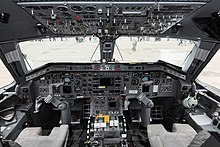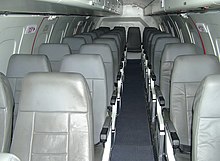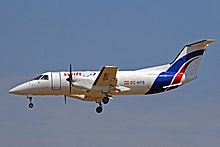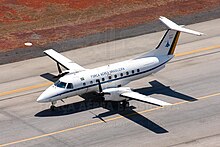Embraer EMB 120 Brasilia
| EMB 120 Brasilia | |
|---|---|
 United Express operated by SkyWest | |
| General information | |
| Type | Turboprop regional airliner |
| National origin | Brazil |
| Manufacturer | Embraer |
| Status | In service |
| Primary users | Brazilian Air Force |
| Number built | 358[1] |
| History | |
| Manufactured | 1983–2001[2] |
| Introduction date | October 1985[3] |
| First flight | 27 July 1983[3] |
The Embraer EMB 120 Brasilia is a twin-turboprop 30-passenger commuter airliner designed and manufactured by the Brazilian aircraft manufacturer Embraer.
The EMB 120 began development during 1974. While initially conceived as a modular series of aircraft, the Family 12X and referred to as the Araguaia, intending to achieve a high level of commonality with the EMB 121 Xingu, the aircraft was redesigned and relaunched with the Brasilia name scheme during 1979. The redesign, which drew on operator feedback, reduced the seating capacity somewhat while removing commonality with the EMB 121. Its size, speed, and ceiling enabled faster and more direct services to be flown in comparison to similar aircraft. The EMB 120 features a circular cross-section fuselage, low-mounted straight wings and has a T-tail.
On 27 July 1983, the prototype performed its maiden flight. During October 1985, the first EMB 120 entered service with Atlantic Southeast Airlines; it quickly entered service with numerous regional airlines, particularly those in the lucrative US market. While the majority of sales were made to civilian operators, a few military customers were also garnered for the type; a specialised VIP transport version, the VC-97, was operated by the Brazilian Air Force. Numerous models were developed to fulfil differing roles and requirements; these included the flexible EMB120 Convertible and the extended range EMB120ER. During 2001, production of the EMB 120 was terminated; it was the last turboprop-powered airliner to be produced by Embraer.
Design and development
[edit]Background
[edit]

Following on from the success of the EMB 110 Bandeirante, Embraer commenced work on developing their first transport category airliner in 1974. At one point, this cumulated in the Family 12X, which comprised three models with modular design concept: EMB 120 Araguaia, EMB 123 Tapajós and EMB 121 Xingu.[3] The original concept for the EMB 120 would have been a relatively straightforward stretch of the EMB 121, facilitating a high degree of commonality between the two types. However, the EMB 121 would be the sole 12X model that was actually produced in its original form; the EMB 120 would be redesigned during 1979, disposing of the Araguaia name at the same time.[3]
At the official launching of the project, held in 1979, the name Brasilia was first applied to the EMB 120.[3] Reportedly, the concept had been heavily revised on the basis of suggestions that had been gathered from prospective operators attending Commuter Airline Association of America (CAAA) convention, and the renaming was to reflect the level of alteration to the EMB 120. Being a completely new aircraft, it was no longer related to the 12X family, and had effectively no parts in common with the EMB 121 Xingu. Furthermore, the capacity was revised downwards from 30 to 24 seats. It had originally been designed to be powered by a pair of Pratt & Whitney Canada PW115 turboprop engine, which was capable of 1,500 shp, the aircraft was subsequently redesigned to make use of more powerful PW118 engines, which produced up to 1,892 shp.[4][3]
In terms of its basic configuration, the EMB 120 features a circular cross-section fuselage, low-mounted straight wings and has a T-tail.[3] The fuselage is of semi-monocoque design, its skin being composed of an aluminium alloy. The wing structure comprises a single three-spar design that is linked to the frames of the lower side of the fuselage, while the nose cone, dorsal fin and leading edges of the wing and tailplane primarily comprise a Kevlar-reinforced glass fibre.[3] The EMB 120 is equipped with retractable tricycle landing gear, which is actuated hydraulically. It is fitted with Goodrich-supplied wheels, oleo-pneumatic shock absorbers, a Hydro Aire anti-skid system, and either carbon or steel brakes.[3]
Into flight
[edit]On 27 July 1983, the PW115-powered EMB 120 prototype performed its maiden flight.[3] The type was able to rapidly attract interest from numerous regional airlines, particularly those based in the United States. Its size, speed, and ceiling enable faster and more direct services to be flown around the US and Europe in comparison to similar aircraft. During October 1985, the first aircraft entered service with Atlantic Southeast Airlines.[3]
Numerous models would be developed to suit different operational circumstances; the EMB120RT featured a reduced take off weight, while the EMB120 cargo freighter had an elevated payload capacity of 4,000 kg; the EMB120 Combi and EMB120 Convertible emphasised flexible operations.[3] During 1993, the first deliveries of the EMB120ER, an extended range model, took place; it was thereafter adopted as the standard production model. Furthermore, hot-and-high versions of these models were commonly equipped with PW118A engines that retain their power ratings at a higher altitude.[3] The EMB120ER Advanced incorporates a range of external and interior improvements in comparison to most other models. The EMB 120RT could be upgraded to the EMB 120 ER; older aircraft were retrofitted to this standard via a Service Bulletin.[5]
During 2001, production of the EMB 120 was terminated. As of 2021, Embraer has not manufactured a turboprop-powered successor, although company executives have occasionally hinted at there being interest in doing so at some point.[6]
Operational history
[edit]The majority of the EMB 120s were sold in the United States and other countries across the Western Hemisphere. US airlines operating the type have included Great Lakes Airlines, which had six EMB 120s in its fleet, while Ameriflight was flying ten freighter-configured EMB 120s as late as 2022. The largest operator of the type in the United States was SkyWest Airlines, which operated more than 62 at one point in its history (c. 2006). SkyWest retired the fleet in early 2015.[citation needed] Several European airlines, such as Régional in France, Atlant-Soyuz Airlines in Russia, DAT in Belgium, and DLT in Germany, also purchased EMB 120s.[citation needed]
The EMB 120 has also proven itself to be popular amongst African operators. One of the biggest operators in the region was the charter operator Sahara African Aviation, which had flown as many as nine EMB 120ERs.[citation needed] Into the 2020s, numerous airlines have opted to retain a handful of examples in their active fleet. It has been commonly contrasted against the ubiquitous Douglas DC-3, often being used as a more modern substitute for the aging classic and possessing roughly double the speed.[citation needed]
Several military operators also procured the type, such as the Angolan Air Force, which received new-build aircraft during 2007.[7] A specialised VIP transport version, the VC-97, was produced and procured by the Brazilian Air Force.[citation needed]
Variants
[edit]
- EMB 120
- Basic production version.
- EMB 120ER
- Extended range and increased capacity version. All EMB 120ER S/Ns may be converted into the EMB 120FC or EMB 120QC models if desired.[8]
- EMB 120FC
- Full cargo version.
- EMB 120QC
- Quick change cargo version.
- EMB 120RT
- Transport version. All EMB-120RT S/Ns may be converted into the model EMB-120ER.[8]
- VC-97
- VIP transport version for the Brazilian Air Force.
Operators
[edit]
Civil operators
[edit]As of July 2018, 105 Brasilias were in airline service: 45 in North/South America, 26 in Africa, 14 in Europe and 20 in Asia-Pacific, with major operators:[9][needs update]
- As Salaam Air (2 passenger)
- Ameriflight (16 freighters)
- Swiftair Hellas (5 freighters)
- Freight Runners Express (9 passenger and freighters)
- Airnorth (7)
- InterCaribbean Airways (7)
- Skippers Aviation, Freedom Airlines Express (6)
- Berry Aviation (9)(freighters, on demand cargo)
- Budapest Aircraft Service (4)
- Allegiance Air (2)
- Sahara African Aviation (18)
- Flight West Airlines Australia (9)
Military operators
[edit]- Brazilian Air Force - 20 transports[10]
- Uruguayan Air Force - 1 transport[10]
Specifications (EMB 120)
[edit]
Data from Jane's All The World's Aircraft 1988-89[11]
General characteristics
- Crew: 2 pilots and 1 flight attendant
- Capacity: 30 passengers
- Length: 20.00 m (65 ft 7 in)
- Wingspan: 19.78 m (64 ft 11 in)
- Height: 6.35 m (20 ft 10 in)
- Wing area: 39.43 m2 (424.4 sq ft)
- Aspect ratio: 9.9:1
- Airfoil: root: NACA 23018 mod.; tip: NACA 23012
- Empty weight: 7,070 kg (15,587 lb)
- Max takeoff weight: 11,500 kg (25,353 lb)
- Maximum landing weight: 11,250 kg (24,802 lb)
- Fuel capacity: 3,340 L (880 US gal; 730 imp gal), with 3,312 L (875 US gal; 729 imp gal) usable
- Powerplant: 2 × Pratt & Whitney Canada PW118 turboprop engines, 1,342 kW (1,800 hp) each
- Propellers: 4-bladed Hamilton Standard 14RF-9 constant-speed, fully-feathering, 3.20 m (10 ft 6 in) diameter
Performance
- Maximum speed: 608 km/h (378 mph, 328 kn) at 6,100 m (20,000 ft)
- Cruise speed: 552 km/h (343 mph, 298 kn)
- Stall speed: 162 km/h (101 mph, 87 kn) (flaps down) (CAS)
- Range: 1,750 km (1,090 mi, 940 nmi) (30 passengers, reserves for 185 km (115 mi; 100 nmi) divert and 45 minute hold)
- Service ceiling: 9,085 m (29,800 ft)
- Rate of climb: 11.0 m/s (2,160 ft/min)
Accidents and incidents
[edit]- On 19 September 1986, an Atlantic Southeast Airlines EMB 120RT (N219AS) struck a mountain near Mantiqueira, Brazil while being delivered to Atlantic Southeast, killing all five on board.[12]
- On 21 December 1987, an Air Littoral Flight 1919 crashed into trees during approach to the wrong runway at Bordeaux–Mérignac Airport (South-West of France). All 16 occupants died.[13]
- On 8 July 1988, Brazilian Air Force EMB 120RT Brasília FAB-2001 crashed during an engine-out landing at São José dos Campos. Five of the nine occupants died.[14]
- On 5 April 1991, Atlantic Southeast Airlines Flight 2311, operating for Delta Connection, crashed on approach to Glynco Jetport in Brunswick, Georgia. The crash claimed the lives of all twenty-three people on board, including former U.S. Senator John Tower of Texas and astronaut Sonny Carter. This was due to propeller control failure which led to incorrect propeller blade angles.
- On 11 September 1991, Continental Express Flight 2574 broke up in flight and crashed at Eagle Lake, Texas, killing all 14 passengers and crew members onboard. The NTSB determined that missing screws on the horizontal stabilizer led to part of it detaching from the aircraft.[15]
- On 21 August 1995, one of the blades on Atlantic Southeast Airlines Flight 529's number-one propeller sheared off, partly tearing the left engine from its mount and increasing drag on the left side. It crashed in a field near Carrollton, Georgia. Of the twenty-nine people on board, ten died (one casualty was from a heart attack nearly eight weeks after the accident).
- On 9 January 1997, Comair Flight 3272 crashed in Monroe, Michigan. All of the 29 passengers and crew died. The probable cause was in-flight icing.
- On 21 May 1997, SkyWest Airlines Flight 724, an EMB 120 (N198SW), experienced a total loss of engine power to the right engine and associated engine fire, followed by a total loss of all airplane hydraulic systems, after takeoff from San Diego International-Lindbergh Field, San Diego, California. The airplane sustained substantial damage. The two pilots, one flight attendant, and 14 passengers were not injured. The flight was destined for Los Angeles, California. It diverted to NAS Miramar, San Diego, where it landed at 14:27 hrs.
- On 21 October 1998, a Capital Táxi Aéreo EMB 120RT Brasilia registration PT-WKH crashed due to pilot error during final approach to Pinto Martins International Airport. The two-man crew and one passenger on board were killed, along with one person on the ground. Seven more people were injured.[16]
- On 30 August 2002, Rico Linhas Aéreas Flight 4823 operated by an EMB 120ER Brasília (registration PT-WRQ), en route from Cruzeiro do Sul and Tarauacá to Rio Branco crashed on approach to Rio Branco during a rainstorm, 1,5 km short of the runway. Of the 31 passengers and crew aboard, 23 died.[17]
- On 14 May 2004, Rico Linhas Aéreas Flight 4815 operated by an EMB 120ER Brasília (registration PT-WRO), en route from São Paulo de Olivença and Tefé to Manaus, crashed in the forest about 18 nmi (33 km; 21 mi) from Manaus. All 33 passengers and crew died in the deadliest accident involving the EMB 120.[18]
- On 22 March 2010, an Airnorth EMB 120 (VH-ANB) took off approximately 10.10am (ACST) from Darwin International Airport on a routine simulated engine-failure training exercise known as a V1 cut when it apparently banked sharply to the left and crashed into the nearby bushland at RAAF Base Darwin.[19] The two pilots on board were killed instantly.[20][21][22][23]
- On 14 September 2011, Angolan Air Force EMB 120ER T-500 crashed while attempting to take off from Huambo Airport, killing 17 of 23 people on board.[24]
- On 12 October 2011, a Nationale Regionale Transport EMB 120, registration ZS-PYO (MSN: 120245) performing a charter flight from Libreville to Port Gentil (Gabon) overran runway 21 and came to a stop with the nose gear intact, both main gear struts bent backwards causing the engines to "pitch down" together with the wings. A few passengers sustained minor injuries, but the aircraft was damaged beyond repair and was written off.[25][26]
- On 27 November 2012, an Inter Îles Air EMB 120ER Brasilia (registration number D6-HUA) was underway from Moroni to Anjouan (both in Comoros Islands) on a charter flight with 25 passengers and 4 crew, when after taking off from Moroni's Prince Said Ibrahim International Airport it lost height, and while attempting to return to the airport, waterlanded 200 m (660 ft) off the coast, about 5 km north of the airport. Local fishermen rescued everybody on board. There were only minor injuries, but the aircraft was damaged beyond repair and was written off.[27][28]
- On 3 October 2013, Associated Aviation Flight 361, an EMB 120RT (5N-BJY), was involved in a crash on takeoff from Lagos Airport bound for Akure. The aircraft was on a charter flight taking the body of the former Governor of Ondo State, Dr. Olusegun Agagu, for burial. There were at least 16 reported fatalities amongst passengers travelling in the burial party. Two people who survived the crash died later in hospital.[29][30]
- On 12 October 2017, an Air Guicango EMB-120 (D2-FDO) crashed en route from Dundo to Luanda (both in Angola). Crew declared engine failure and fire prior to losing radio contact. The wreckage was located the following day with no survivors.[31]
- On 4 May 2020, an African Express Airways EMB 120 (5Y-AXO), operating a flight to Baidoa from Mogadishu, was reportedly shot down by a rocket in Somalia. This aircraft was carrying medical aids to fight COVID-19. A total of six people on board died after crash landing near Bardale.[32][33]
- On 11 July 2023, a Halla Airlines EMB-120 (6O-AAD), operating a domestic flight from Garowe to Mogadishu, crashed into a fence at Aden Adde International Airport, while attempting to land on runway 05, after suffering a left landing gear collapse and veering off the runway. All 34 people onboard survived.[34][35] Preliminary data indicated that the pilots lost control of the aircraft after landing due to strong tailwinds and wind shear which caused the left gear to collapse.[36]
- On 28 November 2023, Unity Air Zanzibar EMB-120 (5H-MJH), operating a domestic flight from Zanzibar to Mikumi National Park, Tanzania, veered off runway on landing at Kikoboga Airstrip, sustaining substantial damage. All 33 occupants survived unharmed.[citation needed]
- On 28 November 2023, Sindbar Air EMB-120 (5H-FLM) operating a domestic flight from Mikumi National Park, Tanzania to Zanzibar, veered off runway on take off at Kikoboga Airstrip and crashed into a building, sustaining substential damage. All 34 occupants survived unharmed.[citation needed]
Preserved aircraft
[edit]- PT-ZBA 120001 - Brasília's first prototype, preserved at the Brazilian Airspace Memorial at the entrance of São José dos Campos airport and Embraer plant.[37]
See also
[edit]Related development
Aircraft of comparable role, configuration, and era
References
[edit]Citations
[edit]- ^ "Embraer EMB-120 Brasilia specs". Aviation Safety Network. Flight Safety Foundation.
- ^ Griffin, Matt (19 August 2019). "Embraer celebrates 50th anniversary". ifn.news.
- ^ a b c d e f g h i j k l m "Embraer EMB-120". businessairnews.com. Retrieved 7 November 2022.
- ^ "Embraer 40 anos: A família 12X- in Portuguese". Archived from the original on 22 February 2014. Retrieved 11 February 2014.
- ^ "EMB 120 Brasilia History". Embraer. Archived from the original on 24 August 2011. Retrieved 29 April 2011.
- ^ Cross, Lee (28 June 2021). "Embraer hopeful of a 2022 launch for new turboprop". airwaysmag.com.
- ^ "Embraer Reports Third-Quarter 2007 Deliveries and Updates Order Book" (PDF). Embraer. Archived from the original (PDF) on 7 October 2017.
- ^ a b "Type Certificate No. A31SO" (PDF). Federal Aviation Administration. Archived from the original (PDF) on 2007-06-16. Retrieved 2007-05-14.
- ^ Thisdell & Morris 2018, p. 45
- ^ a b "World air forces". Flightglobal. 2017.
- ^ Taylor 1988, pp. 12–13
- ^ Ranter, Harro. "ASN Aircraft accident Embraer EMB-120RT Brasilia N219AS Mantiqueira, SP". aviation-safety.net. Retrieved 7 November 2017.
- ^ Report of the BEA.
- ^ Accident description for FAB-2001 at the Aviation Safety Network. Retrieved on 13 August 2011.
- ^ Muck, Patti (16 September 1991). "Crash searchers find stabilizer/Discovery points to maintenance mix-up, not bomb". The Houston Chronicle. Retrieved 23 August 2009.
- ^ "ASN Aircraft accident Embraer 120RT Brasilia PT-WKH Fortaleza, CE". Aviation Safety Network. Retrieved 8 July 2013.
- ^ "ASN Aircraft accident Embraer 120ER Brasilia PT-WRQ Rio Branco-Pres. Medici Airport, AC (RBR)". Aviation Safety Network. Retrieved 13 August 2011.
- ^ "ASN Aircraft accident Embraer 120ER Brasilia PT-WRO Manaus, AM". Aviation Safety Network. Retrieved 14 July 2011.
- ^ Hall, Lex (24 March 2010). "Pilots were killed on dangerous exercise". The Australian. Retrieved 25 March 2010.
- ^ "Two pilots killed in Darwin plane crash". Northern Territory News. 22 March 2010. Retrieved 22 March 2010. [dead link]
- ^ "Media briefing: Aircraft accident at Darwin Airport". Australian Transport Safety Bureau. 22 March 2010. Archived from the original on 6 June 2010. Retrieved 22 March 2010.
- ^ Australian Associated Press (22 March 2010). "Two killed in plane crash at Darwin". The Sydney Morning Herald. Retrieved 22 March 2010.
- ^ "Collision with terrain, VH-ANB" (PDF). ATSB. 22 March 2010. Retrieved 5 July 2017.
- ^ Accident description for T-500 at the Aviation Safety Network. Retrieved on 3 October 2013.
- ^ "Accidents and incidentsv news". J.A.C.D.E.C. - Jet Airliner Crash Data Evaluation Centre. 2011. Retrieved 8 July 2013.
- ^ "Accident description". Aviation Safety Network. 2011. Retrieved 8 July 2013.
- ^ Hradecky, Simon. "Accident: Inter Iles E120 near Moroni on 27 November 2012, engine trouble, ditched in the Ocean". The Aviation Herald. Retrieved 27 November 2012.
- ^ Ranter, Harro. "ASN Aircraft accident Embraer EMB-120ER Brasilia D6-HUA Moroni-Prince Said Ibrahim In Airport (HAH)". aviation-safety.net. Retrieved 19 May 2020.
- ^ Faul, Michelle (3 October 2013). "Up to 16 killed as plane nose-dives in Nigeria". Associated Press. Retrieved 5 July 2017.
- ^ Accident description for 5N-BJY at the Aviation Safety Network. Retrieved on 3 October 2013.
- ^ "Crash: Guicango E120 near Dundo on Oct 12th 2017, engine failure, fire, missing aircraft found". avherald.com. Retrieved 14 October 2017.
- ^ "Aircraft accident Embraer EMB-120RT Brasilia 5Y-AXO Bardale Airstrip". Aviation Safety Network. Retrieved 24 April 2021.
- ^ "Crash: East African Express E120 at Berdale on May 4th 2020, aircraft shot down by Ethiopian troops". The Aviation Herald. Retrieved 24 April 2021.
- ^ Noëth, Bart (2023-07-11). "Halla Airlines Embraer EMB-120 Brasilia veers off runway at Mogadishu Airport, Somalia". Aviation24.be. Retrieved 2023-07-12.
- ^ Kaminski-Morrow2023-07-11T13:15:00+01:00, David. "Halla EMB-120 occupants survive landing accident at Mogadishu". Flight Global. Retrieved 2023-07-12.
{{cite web}}: CS1 maint: numeric names: authors list (link) - ^ Kibii, Eliud (28 July 2024). "Halla Airlines aircraft crash in Mogadishu caused by wind shear – ministry". The Star. Retrieved 14 September 2024.
- ^ Daou, Lucio (March 2012). "Photo: PT-ZBA (CN: 120001) Embraer Embraer EMB-120 Brasília". JetPhotos.Net. Retrieved 8 July 2013.
Bibliography
[edit]- Taylor, John W. R., ed. (1988). Jane's All the World's Aircraft 1988–89. Coulsdon, UK: Jane's Information Group. ISBN 0-7106-0867-5.
- Thisdell, Dan; Morris, Rob (21 August – 3 September 2018). "World Airliner Census". Flight International. pp. 24–47. ISSN 0015-3710.
External links
[edit]- "Airport Planning Manual" (PDF). Embraer. 30 October 2000. Archived from the original (PDF) on 21 May 2022. Retrieved 30 March 2018.
